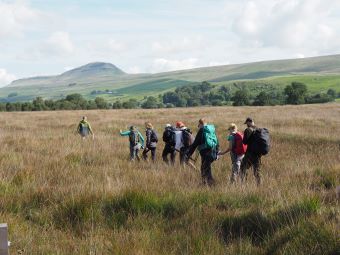Select tab
About
This Lantra-accredited Customised Award is exclusively developed and delivered by a Lantra-approved Training Provider, who meets our quality standards. The course is specifically tailored to meet learners’ needs. For further details about the course content and delivery locations, please contact the Training Provider using the details provided below.
The minimum age to undertake this course is 16.
The Peatland Restoration Practitioner course was developed by Yorkshire Peat Partnership (YPP). The course draws on YPP’s 15 years of experience in all aspects of large-scale blanket bog restoration and is taught by YPP staff working at the forefront of innovative best practice. In this course you will:
The finer details
The course is delivered through in-person instruction in small classes, with a mix of classroom, IT lab and site-based sessions. Interactive learning and group discussions provide peer learning and networking opportunities. Students are assessed through a portfolio of short written tasks completed in class and at home.
Six days of instruction are split into two 3-day blocks, each including a peatland site visit:
• Block 2: Delivery prepares you to deliver upland peatland restoration at scale.
NB This course requires a good level of physical fitness and confidence outdoors: Days onsite involve traversing difficult terrain, including walking across uneven and boggy ground for extended periods.

Recognised by
Yorkshire Wildlife Trust and LANTRACourse description:
Who should attend?
- If you are interested in and motivated by peatland conservation.
- If you are seeking to enter the peatland sector.
- If you are looking to advance your skillset in project managing peatland restoration – from survey to construction.
- If you want to gain formal accreditation of competence as a peatland restoration practitioner.
What will be covered?
Block 1: Preparation
1. Peatland ecology - Learn about peatland formation, ecosystem services associated with peatlands, the historic and current threats faced by the UK’s blanket bogs, and sustainable management.
2. Health and safety - Discuss hazard mitigation and risk assessment for working on upland peatlands. Understand the requirements of CDM Regulations (2015) when working with contractors on peatland restoration projects.
3. Surveying - Explore peatland survey methodology. Harness QGIS for GPS enabled data collection. Identify blanket bog erosion features, habitats and indicator species.
4. Practical restoration - Learn about peatland restoration techniques and see them in action on site.
Block 2: Delivery
5. Restoration plans - Interpret survey data in QGIS. Understand the elements of a peatland restoration plan. Respond constructively to constraints and set-backs.
6. Delivering restoration - Consider contractor procurement and works consenting processes for peatland restoration. Carry out quality control checks.
7. Advocacy and evaluating success - Explore effective stakeholder engagement. Evaluate the impact of restoration works. Learn about monitoring methods.
Search for providers near you
If there are no suitable courses listed above, please fill in the details below and this will display a list of other course providers who also deliver this course.


